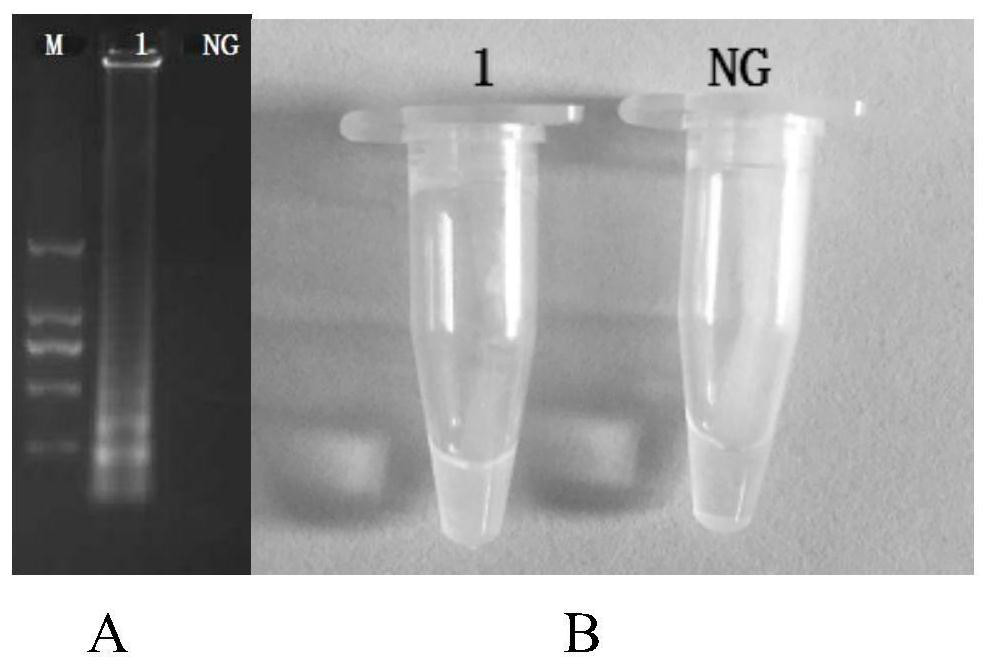CPA detection primer, detection kit and detection method for salmonella
A Salmonella and detection primer technology, applied in the biological field, can solve the problem of high difficulty in the design of reaction primers, and achieve the effects of ensuring reliability, shortening cycle, and short time-consuming
- Summary
- Abstract
- Description
- Claims
- Application Information
AI Technical Summary
Problems solved by technology
Method used
Image
Examples
Embodiment 1
[0039] The primer screening test for detection of Salmonella by cross constant temperature amplification reaction comprises the following steps:
[0040] According to the sequence of the invA gene, after designing with NCBI Primer-Blast, three sets of detection primers with higher scores were selected for comprehensive comparison, and the 4s and 5a primers of each set of primers were used as upstream detection primers and downstream detection primers for PCR amplification. To determine whether the region corresponding to the primer can be amplified and the specificity of the 4s and 5a stripping primers. When the reaction is single and consistent with the size of the corresponding product, that is, the upstream and downstream stripping primers have good specificity. If the stripping primers have non-specific amplification, a ladder-like band will appear, which may lead to subsequent false positive results;
[0041] Three sets of detection primers were designed as follows:
[004...
Embodiment 2
[0064] The method for detecting Salmonella based on cross-primer constant temperature amplification reaction technology comprises the following steps:
[0065] 1. The method for detecting pathogenic microorganisms based on the cross-primer constant temperature amplification reaction technology, the present embodiment takes Salmonella as an example, and the reagents used are as follows:
[0066] a. The stripping primers 4s and 5a, the cross-amplification primers 2a1s, and the specific primers 2a and 3a each at a concentration of 10 μM, the primer sequences are as shown in the preceding SEQ ID NO.1-SEQ ID NO.5;
[0067] b.2×Reaction stock solution: Tris-HCl with concentration of 40.0mM, ammonium sulfate of 20.0mM, potassium chloride of 20.0mM, magnesium sulfate of 16.0mM, Tween 20 of 0.2% (v / v), 1.4M Betaine, 10.0mM dNTPs (each) composition;
[0068] c. Bst DNA polymerase (large fragment, NEB company) aqueous solution with a concentration of 8U / μL;
[0069] d. Mixed solution o...
Embodiment 3
[0080] The cross constant temperature amplification reaction detection Salmonella specificity test comprises the following steps:
[0081] The genomic DNA of Salmonella and non-Salmonella was established according to the reaction system and conditions in Example 1. The cross constant temperature amplification reaction detection method was carried out, and the specificity test was carried out; wherein, the non-Salmonella was: Escherichia coli O157:H7ATCC43895; Escherichia coli O157:H7ATCC43894; Escherichia coli O157:H7E019; Escherichia coli O157:H7E043; Escherichia coli O157:H7E044; Listeria monocytogenes ATCC19116; Listeria monocytogenes ATCC19114, Listeria monocytogenes ATCC19115; Listeria monocytogenes ATCC15313; Listeria monocytogenes Bacteria ATCC19113; Pseudomonas aeruginosa ATCC27853; Staphylococcus aureus ATCC27664; Methicillin-resistant Staphylococcus aureus NCTC10442; Methicillin-resistant Staphylococcus aureus N315; Staphylococcus aureus CA05; Vibrio parahaemolyticus...
PUM
 Login to View More
Login to View More Abstract
Description
Claims
Application Information
 Login to View More
Login to View More - R&D Engineer
- R&D Manager
- IP Professional
- Industry Leading Data Capabilities
- Powerful AI technology
- Patent DNA Extraction
Browse by: Latest US Patents, China's latest patents, Technical Efficacy Thesaurus, Application Domain, Technology Topic, Popular Technical Reports.
© 2024 PatSnap. All rights reserved.Legal|Privacy policy|Modern Slavery Act Transparency Statement|Sitemap|About US| Contact US: help@patsnap.com










